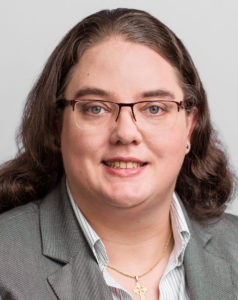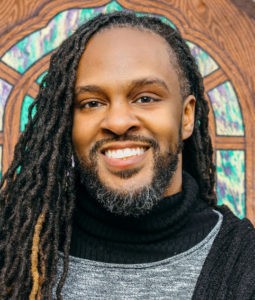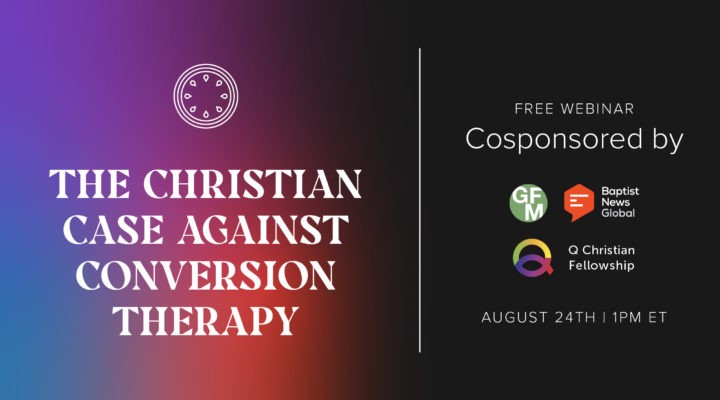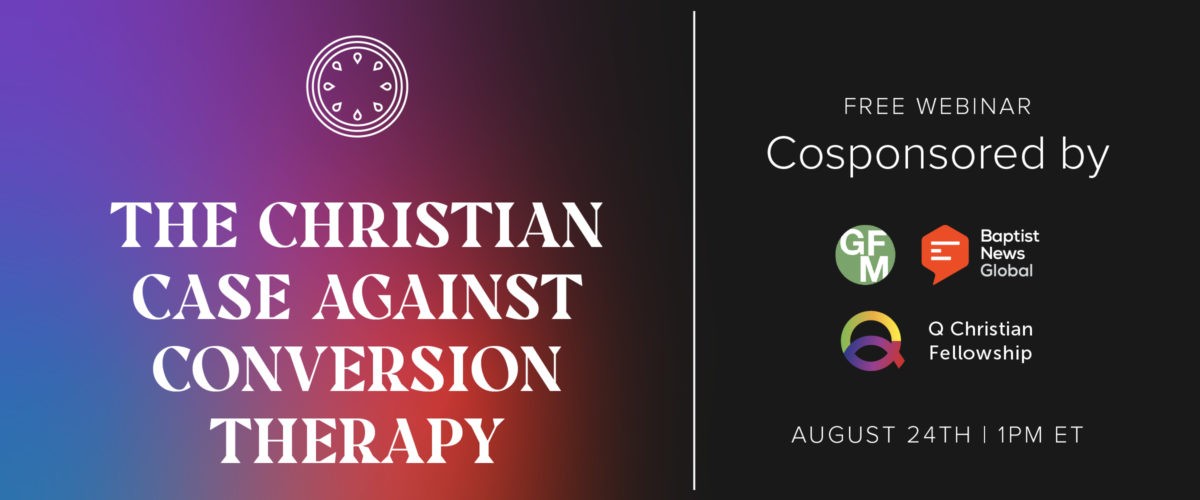Ministries that promise to transform gay people into straight people instead cause immense spiritual, emotional and physical trauma that can take decades of counseling to undo, according to the panelists on an Aug. 24 BNG webinar titled “The Christian Case Against Conversion Therapy.”
In addition to instilling guilt, shame, depression and self-loathing, the panelists warned that such abusive emotional and spiritual practices also frequently lead to suicidal thoughts and completion of suicide as victims attempt to “pray away the gay.”

Amber Cantorna
“I was brought to the brink of suicide because of these theologies that taught me my worth was wrapped up in my sexuality,” said panelist Amber Cantorna, a columnist for Baptist News Global and author of Refocusing My Family: Coming Out, Being Cast Out, and Discovering the True Love of God.
She was joined in the Zoom webinar by Darren Calhoun, a worship leader, justice advocate and associate fellow with Christians for Social Action; and by Casey Pick, senior fellow for advocacy and government affairs for The Trevor Project, which provides crisis intervention and suicide prevention services to LGBTQ people.
The webinar was co-sponsored by BNG, Good Faith Media, Q Christian Fellowship and The Trevor Project. The moderators were Good Faith Media CEO Mitch Randall and BNG Executive Director Mark Wingfield.
The discussion was held in the wake of release of the new Netflix documentary “Pray Away” and release of a series of videos about conversion therapy produced by Good Faith Media.
‘That scared me’
The panelists shared their own experiences with variations of the discredited practice encountered in homes and churches and other settings. They also exposed the toxic theologies that often inform conversion therapy and offered LGBTQ Christians and their supporters tips on how to identity emotionally and spiritually safe churches where to find acceptance and healing.

Casey Pick
Conversion therapy is any counseling, treatment or other attempt to change a person’s sexual orientation to heterosexual or gender identity to cisgender, Pick said. And it can go by different names, such as reparative therapy, ex-gay ministry or a variety of other labels.
Pick said she never underwent formal efforts to change her lesbian identity, but “I tried to DIY it” by adopting techniques she learned on the internet after being told as a teenager that she was a sinner and God hated her.
“That scared me. I wanted to control this. I wanted to be accepted like everyone else,” she said.
One technique she used was to wear a rubber band around her wrist and snap it any time she thought another girl was pretty. “It didn’t do a thing about my sexual orientation, but it did hurt.”
Such practices also launched years of distrust of all those who offered guidance around her sexuality, including therapists, she said. “Conversion therapy culture affected me, and it’s taken decades to get over.”
Cantorna experienced a familial version of conversion therapy when her family disowned her after coming out at 27. “They believed that to be gay is a sin in the eyes of God and to associate with me would put their souls in danger.”
That approach demonstrated a system of belief that “permeates churches and family dinner tables: that you are, as a gay person, fundamentally wrong,” she explained.

Darren Calhoun
Church settings are where Calhoun said he embraced the worldview and ministry associated with conversion therapy as he tried “not to be gay anymore with the idea that to go to heaven, I had to not be gay.”
Church leaders encouraged him to distance himself from family and friends and to abstain from sexual behavior. “Some say if you change your actions you’re not gay anymore. I changed my behavior, but I couldn’t change my desire,” he said.
“While the intent is good, my pastor didn’t know what he was talking about,” Calhoun recalled. “He was just doing what was from the culture. No one in church would say this is conversion therapy, but it was the ethos that I needed to become heterosexual.”
‘The shame and guilt’
Calhoun said he is still dealing with the after-effects of those faith-based attempts to change his sexual orientation. He undergoes therapy on a weekly basis to treat the PTSD caused by decades of struggle around sexual identity, which also has broken the way he relates to others.
“I considered suicide,” he said. “When you live with trauma, trauma doesn’t go away. There are profound costs, and I have not counted them all yet.”
Pick reported on The Trevor Project’s 2020 research about conversion therapy and suicide: 10% of LGBTQ youth reported undergoing conversion therapy, with 78% reporting it occurred when they were under age 18. Youth who reported undergoing conversion therapy reported more than twice the rate of attempting suicide in the past year compared to those who did not.
“They tell you that being gay contributes to destructive behaviors, but it is the shame and guilt (from conversion therapy) that contributes to the destructive behaviors.”
“They tell you that being gay contributes to destructive behaviors, but it is the shame and guilt (from conversion therapy) that contributes to the destructive behaviors,” she said. “Any theology that does not lead to loving themselves, their neighbor and their God, that’s bad fruit.”
Rooted in religious belief
Despite the discredited work of conversion therapy groups such as Exodus International, there has been a recent resurgence of conversion-style therapies, and many of them are rooted in religious belief, Pick reported.
Yet homophobia extends well beyond religious boundaries, while sometimes even carrying religious arguments into secular or atheistic systems, she said, citing as an example some non-religious conversion therapies based on Jungian or Freudian psychologies. “If they are homophobic, transphobic or biphobic, they will find an argument.”
‘It’s about holiness’
Since 20 states have banned conversion therapy and practitioners have faced successful litigation, practitioners now are using increasingly vague language to describe what they’re doing, Pick said.
Calhoun added that the approach is also becoming bound up with Christian nationalist movements that are pushing “super straight” and “straight pride” rhetoric.
The anti-gay movement is given to speaking in code, Pick added, rather than openly admitting that a culture of heterosexuality only is their goal.
The anti-gay movement is given to speaking in code, Pick added, rather than openly admitting that a culture of heterosexuality only is their goal.
In religious circles, the anti-gay movement often gets framed as being about holiness, she said. “That sounds wonderful. I go to church. I want to be holy that way. But when you pair that with a theology that puts (the ideal of ) husband, wife, baby on such a pedestal … then it is very clear what is being promoted.”
Some good news
But there is good news for LGBTQ people, the panelists said.
“We are in a golden age of churches coming from traditions and backgrounds that embrace their traditions and their LGBTQ members for who they are,” Pick said.
Many of those congregations may be found at ChurchClarity.org, said Cantorna, who also recommended reading Changing Our Mind, by BNG columnist David Gushee, for those who want to live into a Christianity that is LGBTQ affirming and rooted in biblical tradition. She and other panelists also noted the breadth of resources currently offered by The Trevor Project, Q Christian Fellowship and The Reformation Project, among others.
The Q Christian Fellowship’s Good Fruit Project offers free downloadable resources for LGBTQ Christians and their allies, Pick said. “The most important work is going to happen around hearts and minds, around dinner tables and in pews and church offices” when leaders ask, “What happens if a kid comes out as gay in our youth group?”
Calhoun suggested steering clear of churches that have no policies on how to affirm LGBTQ members — especially if they believe they have no LGBTQ congregants.
Which is definitely not the case, Cantorna added. “They have LGBTQ people in their pews whether they know it or not.”
Watch the full webinar here.
Additional resources:
Video testimonies on conversion therapy produced by Good Faith Media
Good Fruit Project produced by The Trevor Project
‘Pray Away’ and the harms of the conversion therapy movement | Opinion by Amber Cantorna
On banning conversion therapy: Listen with your heart | Opinion by Bob Browning


